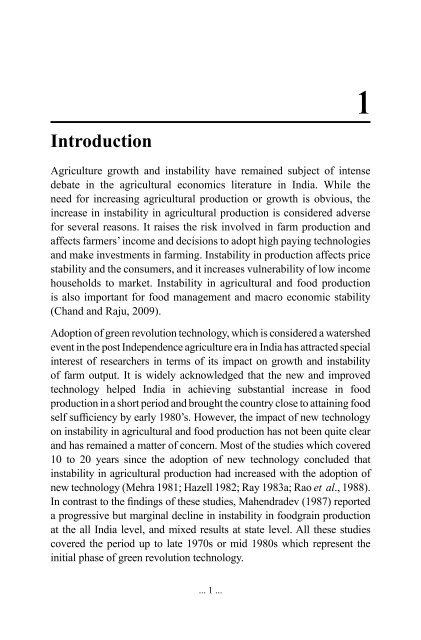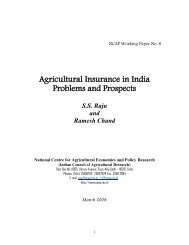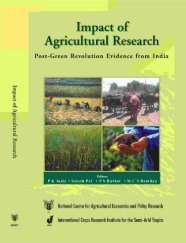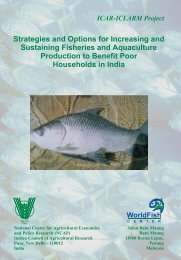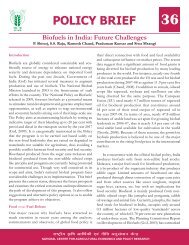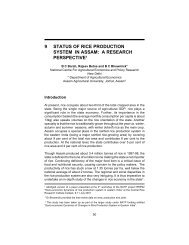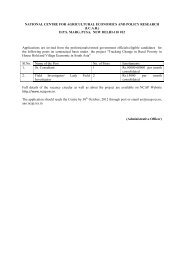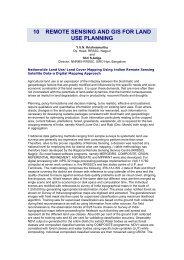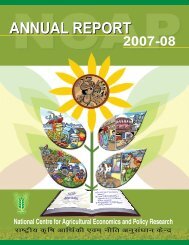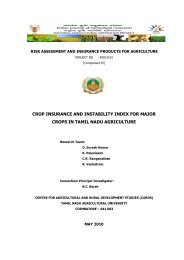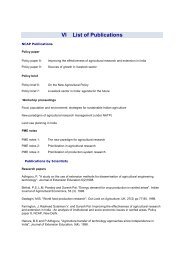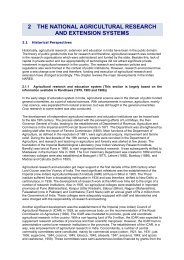Instability in Indian Agriculture - NCAP
Instability in Indian Agriculture - NCAP
Instability in Indian Agriculture - NCAP
You also want an ePaper? Increase the reach of your titles
YUMPU automatically turns print PDFs into web optimized ePapers that Google loves.
Introduction<br />
1<br />
<strong>Agriculture</strong> growth and <strong>in</strong>stability have rema<strong>in</strong>ed subject of <strong>in</strong>tense<br />
debate <strong>in</strong> the agricultural economics literature <strong>in</strong> India. While the<br />
need for <strong>in</strong>creas<strong>in</strong>g agricultural production or growth is obvious, the<br />
<strong>in</strong>crease <strong>in</strong> <strong>in</strong>stability <strong>in</strong> agricultural production is considered adverse<br />
for several reasons. It raises the risk <strong>in</strong>volved <strong>in</strong> farm production and<br />
affects farmers’ <strong>in</strong>come and decisions to adopt high pay<strong>in</strong>g technologies<br />
and make <strong>in</strong>vestments <strong>in</strong> farm<strong>in</strong>g. <strong>Instability</strong> <strong>in</strong> production affects price<br />
stability and the consumers, and it <strong>in</strong>creases vulnerability of low <strong>in</strong>come<br />
households to market. <strong>Instability</strong> <strong>in</strong> agricultural and food production<br />
is also important for food management and macro economic stability<br />
(Chand and Raju, 2009).<br />
Adoption of green revolution technology, which is considered a watershed<br />
event <strong>in</strong> the post Independence agriculture era <strong>in</strong> India has attracted special<br />
<strong>in</strong>terest of researchers <strong>in</strong> terms of its impact on growth and <strong>in</strong>stability<br />
of farm output. It is widely acknowledged that the new and improved<br />
technology helped India <strong>in</strong> achiev<strong>in</strong>g substantial <strong>in</strong>crease <strong>in</strong> food<br />
production <strong>in</strong> a short period and brought the country close to atta<strong>in</strong><strong>in</strong>g food<br />
self sufficiency by early 1980’s. However, the impact of new technology<br />
on <strong>in</strong>stability <strong>in</strong> agricultural and food production has not been quite clear<br />
and has rema<strong>in</strong>ed a matter of concern. Most of the studies which covered<br />
10 to 20 years s<strong>in</strong>ce the adoption of new technology concluded that<br />
<strong>in</strong>stability <strong>in</strong> agricultural production had <strong>in</strong>creased with the adoption of<br />
new technology (Mehra 1981; Hazell 1982; Ray 1983a; Rao et al., 1988).<br />
In contrast to the f<strong>in</strong>d<strong>in</strong>gs of these studies, Mahendradev (1987) reported<br />
a progressive but marg<strong>in</strong>al decl<strong>in</strong>e <strong>in</strong> <strong>in</strong>stability <strong>in</strong> foodgra<strong>in</strong> production<br />
at the all India level, and mixed results at state level. All these studies<br />
covered the period up to late 1970s or mid 1980s which represent the<br />
<strong>in</strong>itial phase of green revolution technology.<br />
... 1 ...


